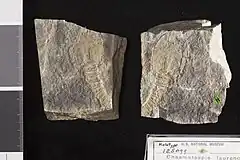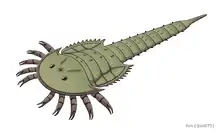Chasmataspis
Chasmataspis is a genus of chasmataspidid, a group of extinct aquatic chelicerate arthropods.[1][2] It was found in the Early Ordovician deposits of Tennessee, United States.[3]
| Chasmataspis Temporal range: Early Ordovician | |
|---|---|
 | |
| Holotype specimen | |
 | |
| Life reconstruction of C. laurencii | |
| Scientific classification | |
| Domain: | Eukaryota |
| Kingdom: | Animalia |
| Phylum: | Arthropoda |
| Subphylum: | Chelicerata |
| Clade: | Dekatriata |
| Order: | †Chasmataspidida |
| Family: | †Chasmataspididae Caster & Brooks, 1956 |
| Genus: | †Chasmataspis Caster & Brooks, 1956 |
| Type species | |
| †Chasmataspis laurencii Caster & Brooks, 1999 | |
Morphology
Just like other chasmataspidids, the body of Chasmataspis compose of a prosoma and a 13-segmented opisthosoma, with the latter subdivided into a 4-segmented preabdomen and a 9-segmented postabdomen.[4] Dorsal to the carapace were pairs of ridges, lateral eyes and median ocelli.[4] Chasmataspis characterized by a semicircular carapace (prosomal dorsal shield) with pointed genal spines and preabdomen with fused body segments.[4] Rows of tubercles and spines run through the axial and lateral regions of opisthosoma.[4] The body terminated with a spine-like telson.[4]
There is no body fossils of Chasmataspis with unambiguous appendages being discovered.[4] The only evidence were 2 specimens of disarticulated, claw-bearing appendages discovered from the same stratum which may represent the prosomal appendage (possibly appendage VI[3]) of Chasmastaspis.[4]
References
- Dunlop, Penney & Jekel 2020, p. 16.
- Caster & Brooks 1956.
- Lamsdell, James C.; Gunderson, Gerald O.; Meyer, Ronald C. (2019-01-08). "A common arthropod from the Late Ordovician Big Hill Lagerstätte (Michigan) reveals an unexpected ecological diversity within Chasmataspidida". BMC Evolutionary Biology. 19 (1): 8. doi:10.1186/s12862-018-1329-4. ISSN 1471-2148. PMC 6325806. PMID 30621579.
- Dunlop, Jason A.; Anderson, Lyall I.; Braddy, Simon J. (2003). "A redescription of Chasmataspis laurencii Caster & Brooks, 1956 (Chelicerata: Chasmataspidida) from the Middle Ordovician of Tennessee, USA, with remarks on chasmataspid phylogeny" (PDF). Earth and Environmental Science Transactions of the Royal Society of Edinburgh. 94 (3): 207–225. doi:10.1017/S0263593300000626. ISSN 1473-7116.
Cited bibliography
- Caster, Kenneth E.; Brooks, H. K. (1956). "New fossils from the Canadian–Chazan (Ordovician) hiatus in Tennessee". Bulletins of American Paleontology. 36 (157): 157–199.
- Dunlop, Jason A.; Penney, D.; Jekel, D. (2020). "A summary list of fossil spiders and their relatives" (PDF). World Spider Catalog. Natural History Museum Bern.